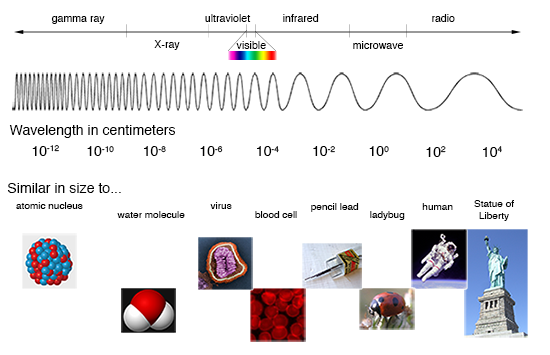Spectra and What They Can Tell Us
Spectra and What They Can Tell Us

A rainbow rises over a misty forest. (Credit: U.S. Fish and Wildlife Service)
A spectrum is simply a chart or a graph that shows the intensity of light being emitted over a range of energies. Have you ever seen a spectrum before? Probably. Nature makes beautiful ones we call rainbows. Sunlight sent through raindrops is spread out to display its various colors (the different colors are just the way our eyes perceive radiation with slightly different energies).
Spectroscopy can be very useful in helping scientists understand how an object like a black hole, neutron star, or active galaxy produces light, how fast it is moving, and what elements it is composed of. Spectra can be produced for any energy of light, from low-energy radio waves to very high-energy gamma rays.
Each spectrum holds a wide variety of information. For instance, there are many different mechanisms by which an object, like a star, can produce light. Each of these mechanisms has a characteristic spectrum.
The Electromagnetic Spectrum
White light (what we call visible or optical light) can be split up into its constituent colors easily and with a familiar result: the rainbow. All we have to do is use a slit to focus a narrow beam of the light at a prism. This setup is actually a basic spectrometer.

Spectrum of white light
The resultant rainbow is really a continuous spectrum that shows us the different energies of light (from red to blue) present in visible light. But the electromagnetic spectrum encompasses more than just optical light. It covers all energies of light, extending from low-energy radio waves, to microwaves, to infrared, to optical light, to ultraviolet, to very high-energy X-rays and gamma rays.
![]() Tell Me More About the Electromagnetic Spectrum!
Tell Me More About the Electromagnetic Spectrum!
What Can Scientists Learn From a Spectrum?

Emission or Bright Line

Absorption or Dark Line

Three types of spectra: continuous, emission line and absorption.(Credit: NASA's Imagine the Universe)
Each element in the periodic table can appear in gaseous form and will produce a series of bright lines unique to that element. Hydrogen will not look like helium which will not look like carbon which will not look like iron... and so on. Thus, astronomers can identify what kinds of stuff are in stars from the lines they find in the star's spectrum. This type of study is called spectroscopy.
The science of spectroscopy is quite sophisticated. From spectral lines astronomers can determine not only the element, but the temperature and density of that element in the star. The spectral line also can tell us about any magnetic field of the star. The width of the line can tell us how fast the material is moving. We can learn about winds in stars from this. If the lines shift back and forth we can learn that the star may be orbiting another star. We can estimate the mass and size of the star from this. If the lines grow and fade in strength we can learn about the physical changes in the star. Spectral information can also tell us about material around stars. This material may be falling onto the star from a doughnut-shaped disk around the star called an accretion disk. These disks often form around a neutron star or black hole. The light from the stuff between the stars allows astronomers to study the interstellar medium (ISM). This tells us what type of stuff fills the space between the stars. Space is not empty! There is lots of gas and dust between the stars. Spectroscopy is one of the fundamental tools which scientists use to study the Universe.
![]() Use Hera to analyze spectra.
Use Hera to analyze spectra.
Updated: August 2013


